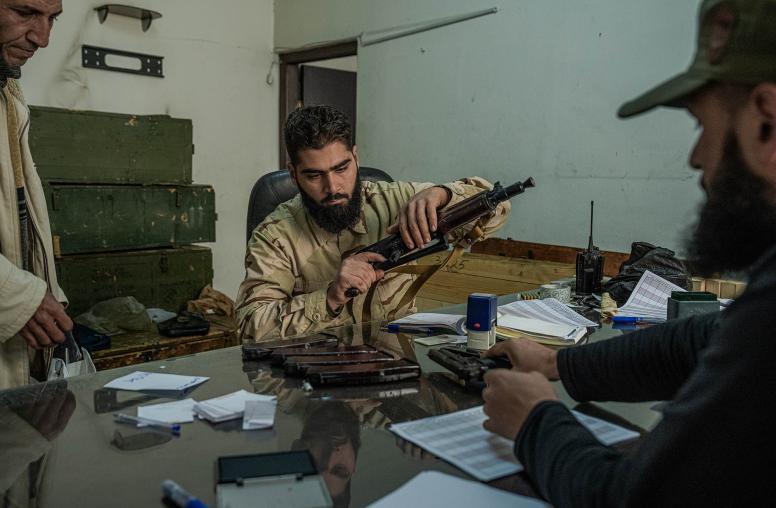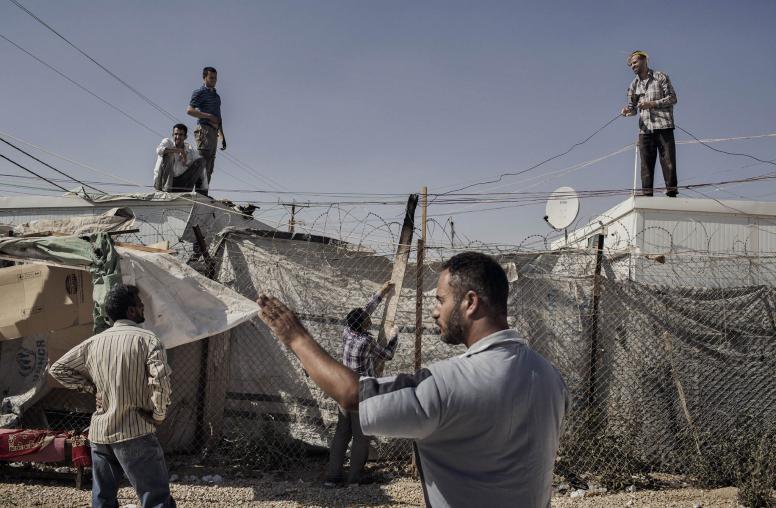In Syria, Russian-Turkish Deal is a Game Changer on the Ground
Moscow, Ankara, and the Assad regime achieve strategic gains as the Kurds experience significant losses.
A chain reaction of events over the past two weeks in Syria have effectively reordered the conflict’s balance of power. Russia has emerged as the key power broker in Syria. Meanwhile, both the Assad regime and Turkey have achieved important gains, while the Kurds have suffered a significant loss. A 10-point deal negotiated between Russia and Turkey—if implemented successfully—will fulfill Turkey’s long-held demand that Kurdish forces be pushed approximately 20 miles off the Syrian-Turkish border. Following a U.S. decision to withdraw the majority of its forces from Syria, the deal also cedes control over significant portions of northeast Syria to the Assad regime and Russia. USIP’s Mona Yacoubian looks at the elements of the Russian-Turkish deal and its implications for Syria and the broader region.

What are the elements of the Russian-Turkish deal?
The deal inaugurates a new phase of Russian engagement in Syria, extending both Russian as well as Turkish influence across northeastern Syria. The deal has several key elements:
- It allows Turkey to retain the territory it seized in its initial October 9 incursion into northeast Syria. Following “Operation Peace Spring,” Turkey now occupies a zone that stretches 75 miles along the Syrian-Turkish border between the towns of Tel Abyad and Ras al-Ayn. The Turkish zone extends roughly 20 miles deep into Syrian territory.
- The deal also fulfills Turkey’s demands that Kurdish forces be removed from a 300-mile long swathe of territory across Syria’s border with Turkey, although Turkey will not maintain a presence in the areas outside of the Operation Peace Spring zone.
- Instead, Russian military police and Syrian border guards will enter areas surrounding the 75-mile Turkish-controlled strip in order to “facilitate the removal of YPG [Kurdish forces] elements and their weapons” to a distance of approximately 20 miles from the border. This phase of the agreement is slated to be completed over six days.
- Once Kurdish fighters are removed from these areas, joint Russian-Turkish patrols will take place in a zone that is six miles deep into Syrian territory, except for Qamishli city.
- The agreement also calls for the “return of refugees in a safe and voluntary manner,” and underscores the need to find a lasting political solution to the Syrian conflict through the Russian-led Astana process.
What are the implications of the deal?
Russian influence cemented. The deal cements Russian influence across Syria and positions Moscow to play a leading role in negotiating an eventual political solution to the Syrian war. At the same time, Russia has checked Ankara’s greater ambitions in Syria since maintaining Syria’s territorial integrity remains a key Russian priority. As such, the agreement ensures that Turkey’s latest incursion and occupation of Syrian territory is restricted to the 75-mile long Operation Peace Spring zone. Instead, the Syrian regime and Russia will regain control of large areas of northeast Syria, while Turkey’s role will be limited to joint patrols with Russia in a narrow buffer zone along the Syrian-Turkish border in remaining areas of the region.
Turkey moves deeper into Russia’s orbit. The deal deepens Russian-Turkish cooperation in Syria. It effectively pulls Turkey even further away from the Western orbit with potentially significant implications for NATO. This latest development comes on the heels of Turkey’s controversial purchase of the Russian S-400 missiles defense system earlier this summer. The Turkish-Russian deal led the United States to cease its sale of F-35 fighter jets to Turkey and could trigger additional sanctions.
Diminishing U.S. influence. The Russian-Turkish deal underscores the diminishing influence of the United States in Syria. With President Trump’s announcement of a U.S. troop withdrawal from Syria, Russia has stepped in to fill the void. Video footage of Russian journalists visiting abandoned U.S. outposts serves as a dramatic reminder of how quickly the power dynamic inside Syria is changing.
The current plan is for the United States to maintain a small residual force at the al-Tanf base near the confluence of the Syrian, Jordanian and Iraqi borders as well as possibly in the southeast in order to help the Kurds maintain control of oil fields. However, the viability of these contingents is far from assured given the uncertainties of Syria’s rapidly changing environment and questions about the legal authority under which these forces would remain. U.S. control of Syrian airspace in the southeast for example remains a key question. Questions also remain about the ultimate disposition of the 700-1,000 U.S. forces leaving Syria. While the United States initially announced they would be based in Iraq, the Iraqi government has pushed back insisting instead that these forces transition out of Iraq within four weeks.
Many questions remain given the fast pace of developments in Syria’s northeast. These include:
- How will the Kurds respond? The Kurds are in an extremely weakened position. Kurdish ambitions for an autonomous region have been dashed, and Kurdish forces may not have much choice but to ultimately acquiesce to the deal. However, armed Kurdish elements could also opt to launch underground insurgent operations in Turkish-occupied areas of northeast Syria. Kurdish militia elements may also be faced with the prospect of eventually integrating more formally into the Syrian army. For their part, Kurdish civilians might be spared the bloodbath many had feared, but it is not clear if they will feel comfortable living in areas subject to joint Russian-Turkish patrols. Some may feel compelled to flee their areas, particularly if Turkey follows through on its threat to resettle 1-2 million Syrian refugees.
- What about the stated plan to “facilitate the return of refugees?” The resettlement of Syrian refugees stands as a key demand of Turkish President Erdogan. Turkey hosts the largest number of Syrian refugees, with 3.6 million refugees formally registered in Turkey. Over time, the Turkish public has grown increasingly intolerant of the Syrian refugee presence, particularly as the Turkish economy has faltered. In July, Turkey reportedly began forcibly returning Syrian refugees, sending them to the embattled governorate of Idlib in northwest Syria. While the agreement could facilitate the return of refugees into Syria, many of the areas they would be returned to are dominated by Kurds and other minorities, raising significant concerns about the prospect of ethnic cleansing.


